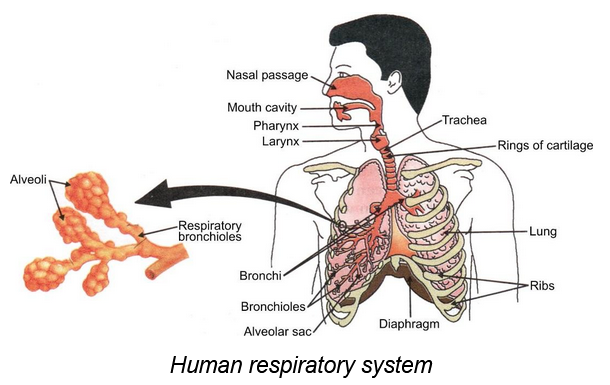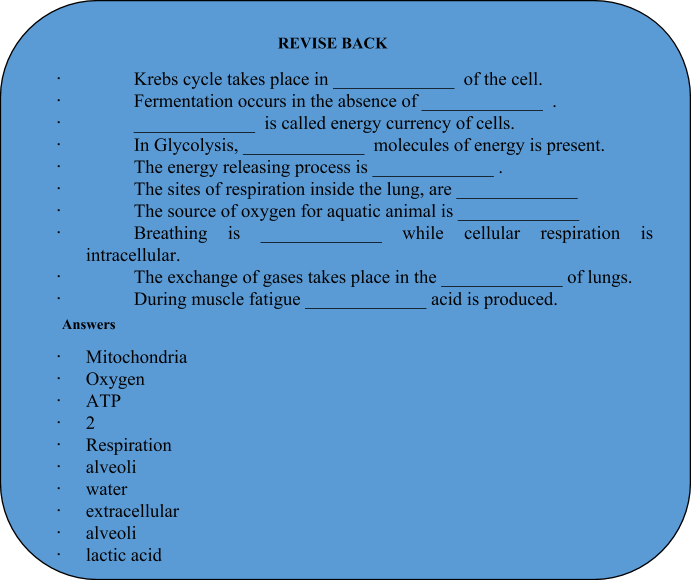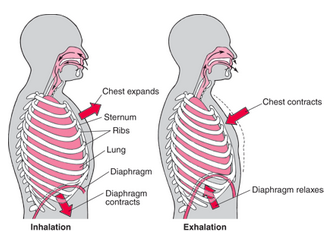
Respiration
Life Process of Class 10
Respiration is an essential physiological activity of all living organisms by which they obtain energy for carrying out all other metabolic activities of the body.It is a catabolic process in which breakdown of complex organic compounds occur and energy is released.
There are two types of respiration:
ANAEROBIC RESPIRATION
When respiration does not involve the uptake of oxygen then this type of respiration is called anaerobic respiration and life in the absence of respiration is called anaerobic respiration and life in the absence of oxygen is called anaerobiosis . Such type of respiration is generally found in the parasitic worms, lower organisms (bacteria, yeast) etc.
AEROBIC RESPIRATION
When respiration involves the uptake of oxygen, then this type of respiration is called aerobic respiration .It requires exchange of O 2 and CO 2 between the organisms and the surroundings. Aerobic respiration takes place inside mitochondria of mammals.
Glucose

Difference between aerobic and anaerobic respiration :
|
S.No. |
Aerobic Respiration |
Anaerobic Respiration |
|
1. |
Takes place in presence of oxygen |
Takes place in absence of oxygen |
|
2. |
Complete breakdown of food takes place |
Partial breakdown of food takes place |
|
3. |
Food gets converted into CO 2 and water. |
Food can be converted into either ethanol and CO 2 (as in yeast) or in lactic acid (as in animal muscles) |
|
4. |
38 molecules of ATP are produced |
2 molecules of ATP are produced. |
ORGANS OF RESPIRATION
Skin or general body surface, as in earthworm.
Air tubes or trachea, as in insects (grasshopper, cockroach, housefly).
Gills as in aquatic animals like fish and prawn.
Lungs as in land animals like frog, lizard, birds, rat, humans.
Frog respires through skin as well as lungs (being amphibious)
All respiratory organs whether skin, trachea, gills or lungs have three common features:
- All the respiratory organs have a large surface area so as to get enough oxygen.
- All have thin walls for easy diffusion and exchange of respiratory gases.
- The respiratory organs like the skin, gills and lungs have a rich blood supply for transport of gases. In the tracheal system, air reaches cells directly and blood plays no role in the transport of gases.
MODES OF RESPIRATION
Cell surface respiration: Exchange of gases takes place directly between cells and the environment (water) across the cell surface. e.g., Sponges, coelenterates, protistans.
Cutaneous respiration: Skin functions as respiratory surface. For such respiration, skin is thin, porous, moist and vascular. e.g., Nereis , Frog (cutaneous respiration is the only mode of respiration during hibernation).
Buccal respiration: This occurs through buccal cavity in frog . The mucus membrane of buccal cavity is thin and moist which serves as the respiratory surface for gas exchange.
Pulmonary respiration: It occurs with the help of lungs and a respiratory tract.
Tracheal respiration: Exchange of gases takes place through trachea. e.g., Insects, peripatus .
Bronchial respiration: Exchange of gases takes place through gills. e.g., Aquatic animals (fishes).
Breakdown of Glucose by Various Pathways
ATP
-
Glucose (6-carbon molecules)
 Pyruvate (3-carbon molecule) + Energy
Pyruvate (3-carbon molecule) + Energy

ATP
- It refers to a nitrogenous compound, Adenosine Tri-Phosphate.
- The energy released during cellular respiration is immediately used to synthesize a molecule called ATP from ADP and inorganic phosphate.

- ATP is used to fuel all activities in the cell. Therefore, it is said to be the energy currency of the cell.
Gaseous Exchange in Plants
Plants need energy. This energy is obtained through the process of respiration:
➲ Plants exchange gases through stomata and the large intercellular spaces ensure that all cells are in contact with air.
➲ CO 2 and O 2 are exchanged by the process of diffusion.
➲ Exchange of gases CO 2 and O 2 in Plants:
At Night → No Photosynthesis only Respiration → CO 2 is given out
At Daytime → Photosynthesis and Respiration → O 2 is given out
- It takes place in all parts of a plant like roots, stem and leaf.
- Exchange of gases in roots take place by the process of diffusion.
- Oxygen diffuses into the root hair and passes into the root cells, from where carbon dioxide moves out into the soil.
- In woody plants, bark has lenticels for gaseous exchange.
- In leaves, respiration takes place by diffusion of oxygen through stomata into cells of the leaf and carbon dioxide is released into the atmosphere.
Opening and Closing of Stomata
- Turgor pressure of guard cells control the opening and closing of stomata.
- When guard cells lose water, turgor process inside the guard cells decrease resulting in the closing of stomata.
- When water gets inside the guard cells, their turgor pressure increases, as a result stomata pore opens.
Related Topics
RESPIRATION IN ANIMALS
Animals have evolved different organs for the uptake of O 2 and release of CO 2 . However in unicellular organisms no specific organ is there for exchange of gases because the entire surface of the organism is in contact with the environment.
Aquatic animals use the O 2 dissolved in water. Since the amount of O 2 in water is fairly low as compared to the amount of O 2 in the air, the rate of breathing in aquatic organisms is much faster than that seen in terrestrial organisms.
Fishes take in water through their mouths and force it past the gills where the dissolved O 2 is taken up by blood.
Fish release carbon dioxide into water. For this exchange, they have special respiratory organs called gills.
Gills are thin, moist membranous structures that are richly supplied with blood.
There are four gills on each side of the body. These four gills are enclosed in a gill chamber. The gill chamber is enclosed by a gill cover called operculum.
Each gill bears a double row of many fine filaments called gill filaments. The gill filaments bear smaller filaments which in turn, divide into smaller branches. So a very large surface area is provided for gaseous exchange when the gills are immersed in water.
The gill filaments are richly supplied with blood capillaries. Exchange of gases takes place through the thin walls of the gill filaments. During breathing, rhythmic movements of the mouth, throat and operculum allow continuous availability of water to the gills.
Blood in capillaries of gill filaments flows in opposite direction to the flow of water over the surface of filaments. This counter current system greatly helps in gaseous exchange as steep concentration gradient of gases is maintained throughout the respiratory surface resulting into efficient gas exchange mechanism.
Gaseous Exchange in Animals
- It takes place with the help of some specific respiratory organs which differs in different animal groups, according their habitat.
- Aquatic animals like fish, prawns and mussels have gills as respiratory organs.
- Land animals like lizard, bird, human have lungs, frogs breathe both by skin and lungs.
- Insects like grasshopper, housefly or cockroach have air tubes or trachea as their respiratory organs.
- In lower animals like Protozoans, Poriferans and Coelenterates, no specialised organs are present for gaseous exchange. It occurs by diffusion through the body surface.
Respiration in Humans
Respiration in human being is a very complex process and involves :
∙ Breathing : It is a physical process in which there is intake of fresh air from the environment and removal of foul air (having more CO 2 ) from the body.
∙ Cellular respiration : It is a biochemical process where food in oxidized in order to release energy.
The main respiratory organs in human beings are lungs.Respiration through lungs is called pulmonary respiration. Atmospheric oxygen is used for repiration. To maintain a high metabolic rate, humans require more oxygen. Rate of breathing under normal conditions is 15 to 18 times per minute. During vigorous exercise, rate increases by about 20 to 25 times.
Many organs take part inthe process of respiration in human beings. They are called organs of respiratory system.
The main organs of human respiratory system are :-
- Nose or nostrils
- Nasal cavity (or Nasal passage)
- Pharynx
- Larynx
- Trachea
- Bronchi
- Bronchioles and alveoli
- Lungs
- Diaphragm
Nose and nostrils : The extenal part of the nose bears two nostrils separated by a cartilaginous septum.In the nostrils, hairs are present which prevent large particles from entering the system. Nostrils also help in detecting odour through their sensory cells.
Nasal passage : From the nostrils, air travels through the nasal cavities or chambers. The nasal chambers are lined with glands which secrete mucous. The nasal chambers perform following functions:
· Warm the air.
· Add moisture to the air.
· The mucous entraps the dust and harmful particles; thus, cleaning the air.
Pharynx (or throat) : The pharynx is a cavity at the back of the mouth, and the nasal cavity opens into it. It is a common passage for food and air.From the nasal cavity, air enters into pharynx and then into wind pipe through a slit called glottis. The glottis gets covered by a small cartilaginous flap-like structure called epiglottis at the time of swallowing of food. epiglottis, thus, prevents the entry of food into the wind pipe at the time of swallowing of food.The pharynx opens into larynx.
Larynx (voice box) : Popularly called “Adam’s apple”, it is a hollow cartilaginous structure leading into the trachea. The larynx contains two ligamentous folds called vocal cords. Vocal cords vibrate to produce sound resulting in speech. In males, the “Adam’s apple” is the protruding cartilage of the voice box.
Trachea (wind pipe): Larynx opens into a long tube called trachea which is supported by incomplete C shaped cartilaginous rings. These rings provide the flexibility and strength to trachea and prevent its collapse when there is not much air in it. Trachea runs in front of oesophagus and after reaching thorax divides into right and left bronchi (singular bronchus) which enter the lungs of their respective side and divide into bronchioles.

Lungs (Respiratory organ)
∙ The lungs lie in the thoracic cavity one on either side of the heart. The cavity is separated from abdominal cavity by a dome shaped muscular partition called diaphragm.
∙ Lungs in man are soft, spongy and of pinkish colour. The passage (trachea) divides into two bronchi in lungs. Inside the lungs each bronchi divides as follows :
→ Bronchi → Bronchioles → Terminal Bronchioles → Alveoli
∙ Alveoli (unit of lungs) are balloon like structure which provides a surface where exchange of gases takes place. The wall of alveoli contains an extensive network of blood vessels.
Mechanism of Breathing in Human
|
Breathing is a complex mechanical process involving muscular movement that alters the volume of the thoracic cavity thereby that of the lung.
♦ Inhalation ♦ Exhalation |
Mechanism of Breathing in Human |
Inhalation (Breathing in)
- Energy requiring process.
- Simultaneous contraction of intercostals muscles and diaphragm results in the movement of ribs outwards and upwards.
- This action increases the volume of thoracic cavity, thus increasing the lung volume.
- It reduces air pressure in the lungs and air rushes into the lungs through air passage.
Exhalation (Breathing out)
- Due to relaxation of intercostals muscles and diaphragm, the ribs return to their original position and diaphragm becomes dome-shaped.
- These movements reduce the volume of thoracic cavity and lungs return to their original volume.
- Air rushes out of the lungs due to increase in pressure above that of atmospheric pressure inside the lungs.
Gas Exchange in Alveoli
- Blood rich in carbon dioxide, i.e., the deoxygenated blood enters the capillary network of alveoli.
- Alveolar air has a higher concentration of oxygen and lower concentration of CO2 than the blood in capillaries.
- Therefore, O 2 diffuses into the capillaries and combines with haemoglobin of red blood cells to form oxyhaemoglobin, to be transported throughout the body.
- CO 2 from blood capillaries diffuses out into the alveolar air.
Gas Exchange in Tissues
- In the cells, continuous metabolism of glucose and other substances results in the production of CO 2 and utilisation of O 2 .
- The concentration of oxygen in the cells and tissue fluid decreases while the concentration of CO 2 increases than in the capillaries.
- Therefore, oxyhaemoglobin breaks down releasing O 2 which diffuses out from the blood capillaries into the tissue fluid and then into each and every cell.











